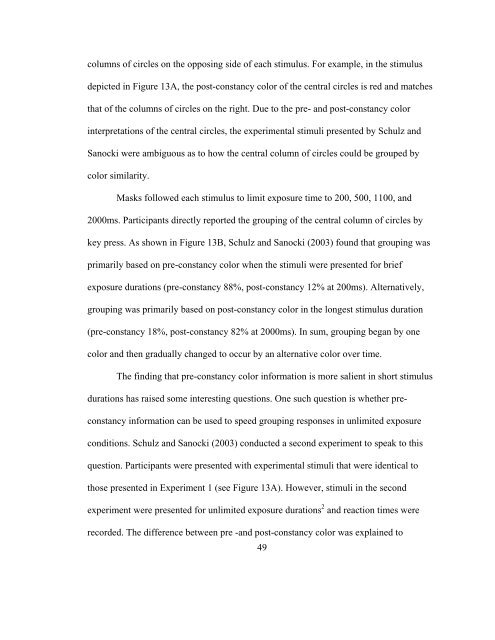The Use of Iambic Pentameter in the
The Use of Iambic Pentameter in the
The Use of Iambic Pentameter in the
You also want an ePaper? Increase the reach of your titles
YUMPU automatically turns print PDFs into web optimized ePapers that Google loves.
columns <strong>of</strong> circles on <strong>the</strong> oppos<strong>in</strong>g side <strong>of</strong> each stimulus. For example, <strong>in</strong> <strong>the</strong> stimulus<br />
depicted <strong>in</strong> Figure 13A, <strong>the</strong> post-constancy color <strong>of</strong> <strong>the</strong> central circles is red and matches<br />
that <strong>of</strong> <strong>the</strong> columns <strong>of</strong> circles on <strong>the</strong> right. Due to <strong>the</strong> pre- and post-constancy color<br />
<strong>in</strong>terpretations <strong>of</strong> <strong>the</strong> central circles, <strong>the</strong> experimental stimuli presented by Schulz and<br />
Sanocki were ambiguous as to how <strong>the</strong> central column <strong>of</strong> circles could be grouped by<br />
color similarity.<br />
Masks followed each stimulus to limit exposure time to 200, 500, 1100, and<br />
2000ms. Participants directly reported <strong>the</strong> group<strong>in</strong>g <strong>of</strong> <strong>the</strong> central column <strong>of</strong> circles by<br />
key press. As shown <strong>in</strong> Figure 13B, Schulz and Sanocki (2003) found that group<strong>in</strong>g was<br />
primarily based on pre-constancy color when <strong>the</strong> stimuli were presented for brief<br />
exposure durations (pre-constancy 88%, post-constancy 12% at 200ms). Alternatively,<br />
group<strong>in</strong>g was primarily based on post-constancy color <strong>in</strong> <strong>the</strong> longest stimulus duration<br />
(pre-constancy 18%, post-constancy 82% at 2000ms). In sum, group<strong>in</strong>g began by one<br />
color and <strong>the</strong>n gradually changed to occur by an alternative color over time.<br />
<strong>The</strong> f<strong>in</strong>d<strong>in</strong>g that pre-constancy color <strong>in</strong>formation is more salient <strong>in</strong> short stimulus<br />
durations has raised some <strong>in</strong>terest<strong>in</strong>g questions. One such question is whe<strong>the</strong>r pre-<br />
constancy <strong>in</strong>formation can be used to speed group<strong>in</strong>g responses <strong>in</strong> unlimited exposure<br />
conditions. Schulz and Sanocki (2003) conducted a second experiment to speak to this<br />
question. Participants were presented with experimental stimuli that were identical to<br />
those presented <strong>in</strong> Experiment 1 (see Figure 13A). However, stimuli <strong>in</strong> <strong>the</strong> second<br />
experiment were presented for unlimited exposure durations 2 and reaction times were<br />
recorded. <strong>The</strong> difference between pre -and post-constancy color was expla<strong>in</strong>ed to<br />
49

















